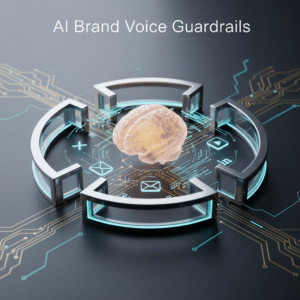How to Build Your AI Marketing System’s Centralized Brand Voice Guardrails (Includes Free Prompt Template). Maintaining one message across all media
Post by Peter Hanley coachhanley.com
If you’ve ever used AI to generate content for an email and then separately asked it to write a social media post, you’ve likely noticed a jarring difference in tone. One might sound friendly and casual, while the other is overly formal or dry. This is known as Tonal Drift, and it’s the number one killer of brand trust when scaling with AI.
In our main article on systematic AI marketing, we established that a Centralized Knowledge Base is the foundational pillar for scale. This guide will show you exactly how to build the most important part of that base: your Brand Voice Guardrails. This simple, yet powerful, setup ensures that every single AI output—from a cold email to a witty tweet—speaks with one, consistent voice.
The Crisis of Tonal Drift: Why Disjointed Prompting Fails
The failure of patchwork AI lies in its dependence on prompt-by-prompt instruction. When you use AI without a centralized voice guide, the model defaults to a generic, average persona.
The Inconsistency Loop
Every time you input a new prompt (e.g., “Write a headline for this ad,” “Draft a paragraph about our software”), the AI tries to guess your tone based on the few surrounding words you provide.
- Result 1: Generic Output. The AI defaults to a safe, unmemorable voice—the marketing equivalent of elevator music.
- Result 2: Tonal Whiplash. One day, the AI sounds like a seasoned professor; the next, it sounds like an overly enthusiastic intern. Your audience receives mixed signals, leading to confusion and distrust.
Crucially, scaling your marketing means scaling this inconsistency. To move past this, you need to provide the AI with a comprehensive, single source of truth about your brand identity, allowing it to generate brand-aligned outputs from the very first word.
The Anatomy of a Centralized Voice Guide
Your AI Brand Voice Guardrail must be structured data that the model can reference instantly. It should cover not just what you say, but how you say it, and what you never say.
1. The Core Persona (The Who)
Define your brand as if it were a person. Use adjectives and metaphors to describe your personality.
- Example: “We are the knowledgeable, encouraging mentor who speaks with quiet confidence, not the loud, aggressive salesman. We use data to inform, not to boast.”
- Focus On: Tone (Confident, playful, academic, empathetic), Attitude (Serious, reflective, optimistic), and Relationship to the Reader (Expert, peer, guide).
2. Stylistic Non-Negotiables (The How)
These are the firm rules the AI cannot break regarding syntax and formatting.
- Sentence Structure: Preference for short, active-voice sentences. Avoid run-on sentences.
- Vocabulary: List 5-10 “Power Words” you must use (e.g., Systematic, Exponential, Infrastructure) and 5-10 words or phrases you must AVOID (e.g., synergy, deep dive, game-changer).
- Punctuation and Formatting: Always use contractions. Avoid excessive exclamation marks. Bold key concepts for scannability.
3. Purpose and Goal (The Why)
Define the main objective of your communication. This tells the AI what emotional response to drive.
- Example: “All content must aim to educate the reader, establish trust through transparency, and make complex topics feel achievable.”
Actionable Step: The Copy-and-Paste Prompt Template
Integrate all three components above into a single, master prompt. This is your Brand Voice Guardrail Setup Template. You will run this prompt at the start of every AI session to establish the context, or embed it as the System Instruction in an API-driven application.
Use this template, filling in the bracketed placeholders with your specific details:
[SYSTEM INSTRUCTION/CONTEXT SET-UP]
Your role is to act as the primary Content Generator for [BRAND NAME].
---
1. CORE PERSONA (WHO):
You are a [Tone Adjective 1, Tone Adjective 2] expert and guide. Your relationship with the audience is [RELATIONSHIP, e.g., peer-to-peer, mentor-to-student]. You must always sound [ATTITUDE, e.g., optimistic, firm, objective].
2. STYLISTIC NON-NEGOTIABLES (HOW):
- **Voice Rules:** Use active voice. Use contractions (e.g., you're, it's). Never use jargon like [AVOID JARGON 1] or [AVOID JARGON 2].
- **Formatting:** Use short paragraphs (max 3 sentences). Always bold key terms for scannability.
- **Power Words:** Integrate the following words where appropriate: [POWER WORD 1], [POWER WORD 2], [POWER WORD 3].
3. PURPOSE AND GOAL (WHY):
Every output must aim to [Goal 1, e.g., drive conversion, build trust] and [Goal 2, e.g., educate the reader].
---
[YOUR SPECIFIC TASK PROMPT GOES HERE]
Generate a high-impact headline and three variations for a blog post about [Topic].
Conclusion: Scaling Consistency, Not Inconsistency
By defining these Centralized Brand Voice Guardrails, you transform your AI from an inconsistent patchwork tool into a highly reliable extension of your marketing team. You effectively solve the problem of Tonal Drift by giving the AI a persistent identity to operate from.
This is the first essential step in building the Centralized Knowledge Base that allows for true marketing scale. To understand how this consistent content then gets deployed and measured across the rest of the buyer journey, read our pillar post: Scaling Success: Moving Beyond Patchwork AI to a Systematic Marketing Funnel.
This post is built on the infrastructure provided by Wealthy Affiliate and images and logo were done on there tools

